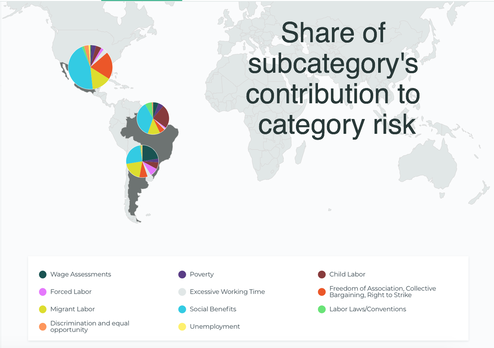Tools.
Easy.
Our tools are designed to provide you with easy access to powerful images and understanding of social risks and opportunities in your supply chains.
Comprehensive.
We have compiled, summarized and interpreted information from hundreds of sources using statistical tools and a hands-on approach.
Transparent.
We use publicly available sources and data, all cited. We use critically-reviewed algorithms and methods, all cited. The SHDB is the opposite of a “black box”: it’s a transparent focusing lens.
State of the Art.
Our methods and assessments are designed by a team of specialists with a strong base in scientific methods and wide knowledge of the complexity of social issues. All our sources and data have been reviewed carefully by research analysts and experts, and we continually update and expand them.
Our tools are designed to provide you with easy access to powerful images and understanding of social risks and opportunities in your supply chains.
Comprehensive.
We have compiled, summarized and interpreted information from hundreds of sources using statistical tools and a hands-on approach.
Transparent.
We use publicly available sources and data, all cited. We use critically-reviewed algorithms and methods, all cited. The SHDB is the opposite of a “black box”: it’s a transparent focusing lens.
State of the Art.
Our methods and assessments are designed by a team of specialists with a strong base in scientific methods and wide knowledge of the complexity of social issues. All our sources and data have been reviewed carefully by research analysts and experts, and we continually update and expand them.
RISK MAPPING TOOL.
The SHDB offers a Risk Mapping Tool to visualize and communicate the social risks present in product supply chains.
The SHDB Risk Mapping Tool helps you identify:
The SHDB Risk Mapping Tool helps you identify:
- Where country and sector social risks are at their highest;
- Which issues rise to the top, among Human Rights, Labor Rights and Decent Work, Local Community, Governance and Health and Safety.
SHDB LICENCES. NEW V5 available Soon.
You can also use the risk data together with a global trade model to assess risks across complete supply chains. Licenses are currently available to use this combined system in LCA software tools: Sima Pro and Open LCA.
The SHDB approach, created by Catherine Benoit Norris and Greg Norris in 2008, published in scientific journals and applied by hundreds of researchers and organizations, helps companies with limited supply chain knowledge to leverage trade data in combination with their own procurement information, to see and learn about the social risks and opportunities that lie upstream in their supply chain.
These tools enable you to:
The SHDB approach, created by Catherine Benoit Norris and Greg Norris in 2008, published in scientific journals and applied by hundreds of researchers and organizations, helps companies with limited supply chain knowledge to leverage trade data in combination with their own procurement information, to see and learn about the social risks and opportunities that lie upstream in their supply chain.
These tools enable you to:
- Begin to map and understand your supply chains even before gathering detailed purchasing data and supplier information;
- Refine your risk assessments with purchasing data;
- Prioritize suppliers so that you pursue supplier-specific information where it matters most;
- Identify Social Hotspots across your supply chains, by impact category and social theme, and in an overall sense;
- Calculate a Social Footprint;
- Compare and prioritize supply chain risks and inform social materiality assessment;
- Measure the effects of programs and actions relative to your baseline, so you can report on progress and put it into perspective;
- Conduct social spend analysis;
- Address both environmental and social impact assessment with one model.







